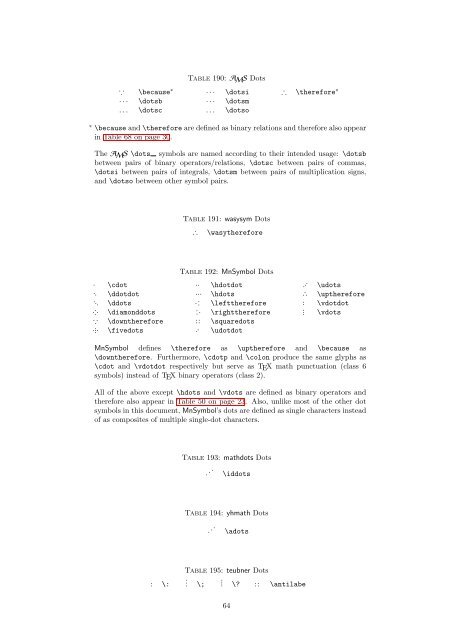symbols-a4
symbols-a4
symbols-a4
Create successful ePaper yourself
Turn your PDF publications into a flip-book with our unique Google optimized e-Paper software.
Table 190: AMS Dots<br />
∵ \because ∗ · · · \dotsi ∴ \therefore ∗<br />
· · · \dotsb · · · \dotsm<br />
. . . \dotsc . . . \dotso<br />
∗ \because and \therefore are defined as binary relations and therefore also appear<br />
in Table 68 on page 30.<br />
The AMS \dots <strong>symbols</strong> are named according to their intended usage: \dotsb<br />
between pairs of binary operators/relations, \dotsc between pairs of commas,<br />
\dotsi between pairs of integrals, \dotsm between pairs of multiplication signs,<br />
and \dotso between other symbol pairs.<br />
Table 191: wasysym Dots<br />
∴ \wasytherefore<br />
Table 192: MnSymbol Dots<br />
⋅ \cdot \hdotdot ⋰ \udots<br />
\ddotdot ⋯ \hdots ∴ \uptherefore<br />
⋱ \ddots \lefttherefore ∶ \vdotdot<br />
\diamonddots \righttherefore ⋮ \vdots<br />
∵ \downtherefore ∷ \squaredots<br />
\fivedots \udotdot<br />
MnSymbol defines \therefore as \uptherefore and \because as<br />
\downtherefore. Furthermore, \cdotp and \colon produce the same glyphs as<br />
\cdot and \vdotdot respectively but serve as TEX math punctuation (class 6<br />
<strong>symbols</strong>) instead of TEX binary operators (class 2).<br />
All of the above except \hdots and \vdots are defined as binary operators and<br />
therefore also appear in Table 50 on page 23. Also, unlike most of the other dot<br />
<strong>symbols</strong> in this document, MnSymbol’s dots are defined as single characters instead<br />
of as composites of multiple single-dot characters.<br />
. \:<br />
Table 193: mathdots Dots<br />
. ..<br />
\iddots<br />
Table 194: yhmath Dots<br />
. ..<br />
\adots<br />
Table 195: teubner Dots<br />
. \;<br />
. \? .. \antilabe<br />
64


